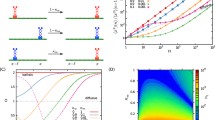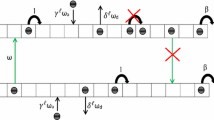Abstract
Cytoskeletal motors known as motor proteins are molecules that drive cellular transport along several parallel cytoskeletal filaments and support many biological processes. Experimental evidences suggest that they interact with the nearest molecules of their filament while performing any mechanical work. These interactions modify the microscopic level properties of motor proteins. In this work, a new version of two-channel totally asymmetric simple exclusion process, that incorporates the intra-channel interactions in a thermodynamically consistent way, is proposed. As the existing approaches for multi-channel systems deviate from analyzing the combined effect of inter and intra-channel interactions, a new approach known as modified vertical cluster mean field is developed. The approach along with Monte Carlo simulations successfully encounters some correlations and computes the complex dynamic properties of the system. Role of symmetry of interactions and inter-channel coupling is observed on the phase diagrams, maximal particle current and its corresponding optimal interaction strength. Surprisingly, for all values of coupling rate and most of the interaction splittings, the optimal interaction strength corresponding to maximal current belongs to the case of weak repulsive interactions. Moreover, for weak interaction splittings and with an increase in the coupling rate, the optimal interaction strength tends towards the known experimental results. The effect of coupling as well as interaction energy is also measured for correlations. They are found to be short-range and weaker for repulsive and weak attractive interactions while they are long-range and stronger for large attractions.







Similar content being viewed by others
References
Alberts, B., Johnson, A., Lewis, J., Walter, P., Raff, M., Roberts, K.: Molecular Biology of the Cell, vol. 4. Garland Science, New York (2002)
Dennis, B.: Cell Movements: From Molecules to Motility. Garland Science, New York (2001)
Howard, J., et al.: Mechanics of Motor Proteins and the Cytoskeleton. University of Washington, Seattle (2001)
Kolomeisky, A.B., Fisher, M.E.: Molecular motors: a theorist’s perspective. Annu. Rev. Phys. Chem. 58, 675–695 (2007)
Debashish, C.: Stochastic mechano-chemical kinetics of molecular motors: a multidisciplinary enterprise from a physicist’s perspective. Phys. Rep. 529(1), 1–197 (2013)
Kolomeisky, A.B.: Motor proteins and molecular motors: how to operate machines at the nanoscale. J. Phys. Condens. Matter 25(46), 463101 (2013)
Kolomeisky, A.B.: Motor Proteins and Molecular Motors. CRC Press, Boca Raton (2015)
Schliwa, M., Woehlke, G.: Molecular motors. Nature 422(6933), 759–765 (2003)
Claudia, V., Christoph, F.S.: Moving into the cell: single-molecule studies of molecular motors in complex environments. Nat. Rev. Mol. Cell Biol. 12(3), 163–176 (2011)
Ally, S., Adam, G.L., Kari, B., Sarah, E.R., Vladimir, I.G.: Opposite-polarity motors activate one another to trigger cargo transport in live cells. J. Cell Biol. 187(7), 1071–1082 (2009)
Driver, J.W., Jamison, D.K., Uppulury, K., Rogers, A.R., Kolomeisky, A.B., Diehl, M.R.: Productive cooperation among processive motors depends inversely on their mechanochemical efficiency. Biophys. J. 101(2), 386–395 (2011)
Driver, J.W., Rogers, A.R., Jamison, D.K., Das, R.K., Kolomeisky, A.B., Diehl, M.R.: Coupling between motor proteins determines dynamic behaviors of motor protein assemblies. Phys. Chem. Chem. Phys. 12(35), 10398–10405 (2010)
Neri, I., Kern, N., Parmeggiani, A.: Exclusion processes on networks as models for cytoskeletal transport. N. J. Phys. 15(8), 085005 (2013)
Uppulury, K., Efremov, A.K., Driver, J.W., Jamison, D.K., Diehl, M.R., Kolomeisky, A.B.: How the interplay between mechanical and nonmechanical interactions affects multiple kinesin dynamics. J. Phys. Chem. B 116(30), 8846–8855 (2012)
Berger, F., Keller, C., Klumpp, S., Lipowsky, R.: Distinct transport regimes for two elastically coupled molecular motors. Phys. Rev. Lett. 108(5), 208101 (2012)
Keller, C., Berger, F., Liepelt, S., Lipowsky, R.: Network complexity and parametric simplicity for cargo transport by two molecular motors. J. Stat. Phys. 150(2), 205–234 (2013)
Berger, F., Keller, C., Klumpp, S., Lipowsky, R.: External forces influence the elastic coupling effects during cargo transport by molecular motors. Phys. Rev. E 91(022701), 022701 (2015)
Roos, W.H., Montel, F., Spatz, J.P., Bassereau, P., Cappello, G., et al.: Dynamic kinesin-1 clustering on microtubules due to mutually attractive interactions. Phys. Biol. 5(4), 046004 (2008)
Andrej, V., Erwin, F., Franz, S., Manfred, T., Young-Hwa, S., Eckhard, M.: Dynamics and cooperativity of microtubule decoration by the motor protein kinesin11 Edited by W. Baumeister. J. Mol. Biol. 312, 1011–1026 (2001)
Seitz, A., Surrey, T.: Processive movement of single kinesins on crowded microtubules visualized using quantum dots. EMBO J. 25(2), 267–277 (2006)
MacDonald, C.T., Gibbs, J.H., Pipkin, A.C.: Kinetics of biopolymerization on nucleic acid templates. Biopolymers 6(1), 1–25 (1968)
Belitsky, V., Krug, J., Neves, E.J., Schütz, G.M.: A cellular automaton model for two-lane traffic. J. Stat. Phys. 107(5–6), 945–971 (2001)
Chowdhury, D., Garai, A., Wang, J.-S.: Traffic of single-headed motor proteins KIF1A: effects of lane changing. Phys. Rev. E 77(5), 050902 (2008)
Widom, B., Viovy, J.L., Defontaines, A.D.: Repton model of gel electrophoresis and diffusion. J. Phys. I 1(12), 1759–1784 (1991)
Chou, T., Mallick, K., Zia, R.K.P.: Non-equilibrium statistical mechanics: from a paradigmatic model to biological transport. Rep. Prog. Phys. 74(11), 116601 (2011)
Dong, J., Klumpp, S., Zia, R.K.P.: Entrainment and unit velocity: surprises in an accelerated exclusion process. Phys. Rev. Lett. 109(13), 130602 (2012)
Campas, O., Kafri, Y., Zeldovich, K.B., Casademunt, J., Joanny, J.-F.: Collective dynamics of interacting molecular motors. Phys. Rev. Lett. 97(3), 038101 (2006)
Klumpp, S., Lipowsky, R.: Phase transitions in systems with two species of molecular motors. Europhys. Lett. (EPL) 66(1), 90 (2004)
Pinkoviezky, I., Gov, N.S.: Modelling interacting molecular motors with an internal degree of freedom. N. J. Phys. 15(2), 025009 (2013)
Slanina, F.: Interaction of molecular motors can enhance their efficiency. Europhys. Lett. (EPL) 84(5), 50009 (2008)
Teimouri, H., Kolomeisky, A.B., Mehrabiani, K.: Theoretical analysis of dynamic processes for interacting molecular motors. J. Phys. A 48(6), 065001 (2015)
Daniel, C.-G., Hamid, T., Kolomeisky, A.B.: Correlations and symmetry of interactions influence collective dynamics of molecular motors. J. Stat. Mech. 2015(4), P04013 (2015)
Hao, Q.-Y., Jiang, R., Hu, M.-B., Jia, B., Wang, W.-X.: Exponential decay of spatial correlation in driven diffusive system: a universal feature of macroscopic homogeneous state. Sci. Rep. 6(19652), 19652 (2016)
Hao, Q.-Y., Chen, Z., Sun, X.-Y., Liu, B.-B., Wu, C.-Y.: Theoretical analysis and simulation for a facilitated asymmetric exclusion process. Phys. Rev. E 94(2), 022113 (2016)
Shaebani, M.R., Sadjadi, Z., Sokolov, I.M., Rieger, H., Santen, L.: Anomalous diffusion of self-propelled particles in directed random environments. Phys. Rev. E 90(3), 030701 (2014)
Curatolo, A.I., Evans, M.R., Kafri, Y., Tailleur, J.: Multilane driven diffusive systems. J. Phys. A 49(9), 095601 (2016)
Schiffmann, C., Appert-Rolland, C., Santen, L.: Shock dynamics of two-lane driven lattice gases. J. Stat. Mech. 2010(06), P06002 (2010)
Evans, M.R., Kafri, Y., Sugden, K.E.P., Tailleur, J.: Phase diagrams of two-lane driven diffusive systems. J. Stat. Mech. 2011(06), P06009 (2011)
Ekaterina, P., Kolomeisky, A.B.: Two-channel totally asymmetric simple exclusion processes. J. Phys. A 37(42), 9907 (2004)
Ekaterina, P., Kolomeisky, A.B.: Asymmetric coupling in two-channel simple exclusion processes. Physics A 372(1), 12–21 (2006)
Juhasz, R.: Weakly coupled, antiparallel, totally asymmetric simple exclusion processes. Phys. Rev. E 76(2), 021117 (2007)
Popkov, V., Salerno, M.: Hydrodynamic limit of multichain driven diffusive models. Phys. Rev. E 69(4), 046103 (2004)
Arvind Kumar, G.: Coupling of two asymmetric exclusion processes with open boundaries. Physica A 392(24), 6314–6329 (2013)
Derrida, B., Domany, E., Mukamel, D.: An exact solution of a one-dimensional asymmetric exclusion model with open boundaries. J. Stat. Phys. 69(3–4), 667–687 (1992)
Derrida, B., Evans, M.R., Vincent, H., Vincent, P.: Exact solution of a 1d asymmetric exclusion model using a matrix formulation. J. Phys. A 26(7), 1493 (1993)
Derrida, B., Evans, M.R.: Bethe ansatz solution for a defect particle in the asymmetric exclusion process. J. Phys. A 32(26), 4833 (1999)
Lakatos, G., Chou, T.: Totally asymmetric exclusion processes with particles of arbitrary size. J. Phys. A 36(8), 2027 (2003)
Acknowledgements
A.K. Gupta gratefully acknowledges the financial support from Department of Science and Technology (DST) (Grant No. SB/FTP/MS-001/2013), Government of India.
Author information
Authors and Affiliations
Corresponding author
Appendices
Appendix A: Expression for bulk current using VCMF approach:
The vertical cluster mean field approach is utilized to compute the bulk current for all eight possible configurations (shown in Fig. 2) contributing to the particle movement in bulk. The total bulk current in the system is an algebraic sum of currents from all of these configurations. We first compute the particle current corresponding to configurations in Fig. 2a–d that doesn’t involve the coupling parameter w i.e. the case when the particle can not hop vertically. We denote total bulk current from these four configurations as
where \(J_a\), \(J_{b}\), \(J_c\), and \(J_{d}\) are particle currents corresponding to configuration (a), (b), (c), and (d), respectively and are given as
thus implying,
Here \(\rho \) = \(V_1 + V_3\) denotes the particle bulk density. Similarly particle bulk current for the configurations in Fig. 2e–h which involves the role of parameter w i.e. when lane switching is possible, can be computed as
where \(J_e\), \(J_{f}\), \(J_g\), and \(J_{h}\) denote particle currents corresponding to configuration (e), (f), (g), and (h), respectively. The total bulk current for the above four configurations is expressed as
The overall bulk current per channel is
For any value of \(\rho \) between zero and one, the rate of formation of particle cluster, \(q = \eta ^{\theta }\), approaches infinity for very large attractive interactions (\(\eta \gg 1)\) and \(\theta > 0\). This causes bulk current to increase without any limit contradicting to the physical scenario of depletion of particle current under large attractive interactions. Similarly, the rate of breaking from a cluster, \(r = \eta ^{(\theta - 1)} \), tends to infinity for \(\eta \rightarrow 0 \) and \(\theta < 1\), for any \(\rho \in (0,1)\).
Appendix B: Monte Carlo simulations
Due to approximate nature of our method in calculating the effect of interactions and correlations, we validate the results obtained from the given approximate theoretical method with extensive Monte Carlo (MC) simulations. Random-Sequential update rules are adopted. For a single Monte Carlo step, first a lattice is randomly chosen with equal probability. To avoid any finite-size and boundary effects both lattices are considered to be of size N = 1000 unless otherwise mentioned. The results have been verified by taking large lattice size of \(N = 5000\). The simulation starts from a random initial distribution of particles on both the lattices and system evolved for \(10^{9}\)–\(10^{10}\) time steps to ensure the steady state condition. To compute density and particle current at steady state, an average of the last \(80\%\) of the steps has been taken. In constructing phase diagrams, density profiles are compared with a precision of 0.01 and for calculating phase boundaries, error estimated in comparing currents is less than \(1\%\). Our predicted theoretical results fit well with the simulation results.
Rights and permissions
About this article
Cite this article
Midha, T., Gupta, A.K. Role of Interactions and Correlations on Collective Dynamics of Molecular Motors Along Parallel Filaments. J Stat Phys 169, 824–845 (2017). https://doi.org/10.1007/s10955-017-1894-8
Received:
Accepted:
Published:
Issue Date:
DOI: https://doi.org/10.1007/s10955-017-1894-8




